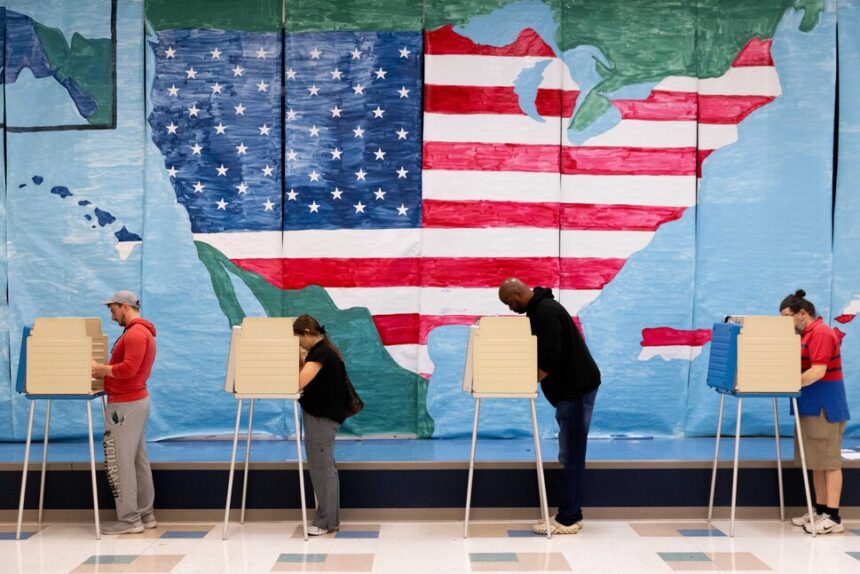The presidential election is officially decided by the states through the Electoral College. But to fully understand the dynamics of the race, it’s also helpful to look at a lower level: the counties.
That’s what U.S. News did through a series examining 15 battleground counties that could prove pivotal in this year’s White House race.
Eleven of the 15 counties are located in the seven presidential swing states – Arizona, Georgia, Michigan, Nevada, North Carolina, Pennsylvania and Wisconsin – on the logic that a county’s electoral weight is greater when it sits in the most competitive states . Three of the remaining four counties are in large states that are on the competitive periphery – Florida and Texas – and one county is in a league of its own because it sits in Nebraska, which splits some of its votes elections by congressional district.
Because current political geography generally correlates with population density – denser cities and suburbs tend to be bluer, while rural areas are generally redder – the 15 counties making up this list are likely a little inclined towards Democratic-leaning areas. Still, the goals were to include counties of different sizes and different partisan trajectories. Seven of the jurisdictions on the list are large urban-suburban counties, three are purely suburban, and the other five are anchored in a mid-sized city rather than a large metropolis.
Counties offer a mix of racial, ethnic and income demographics. Additionally, everyone is in some degree of political transition. How these transitions play out – and how they balance out – could impact who is elected president in 2024.
Here’s more information on the 15 key countries to watch in the 2024 presidential race, along with links to their full profiles.
Brown County, Wisconsin
This blue collar county, home to Green Bay, is politically divided between its urban and rural populations. He’s a Republican, but Democrats are usually competitive.
Clark County, Nevada
This county, which includes Las Vegasis home to nearly three-quarters of Nevada’s population, giving it considerable influence over who wins the hotly contested runoff. swing state.
Cobb County, Georgia
This suburb north of Atlanta is part of another swing state and has become more racially and ethnically diverse over the past two decades, shifting from Republican to Democratic.
Douglas County, Nebraska
This county, which is home to Omaha, represents most of Nebraska’s 2nd congressional district, which under state law has one electoral vote. Unlike the rest of Nebraska, the county supported Democratic candidates Barack Obama, Hillary Clinton and Joe Biden.
Erie County, Pennsylvania
This county, home to the city of Erie, is “a bellwether area in a bellwether state.” No county in Pennsylvania – and perhaps in the country – is as consistently swinging as Erie County.
Fort Bend County, Texas
Texas remains red, but it has become increasingly blue. One reason for this change comes from suburban areas like Fort Bend County. In this country, the pro-democracy shift has been driven by two factors: increasing racial and ethnic diversity and rising levels of education.
Kent County, Michigan
Home to Grand Rapids, Kent County East Michiganis the fourth most populous county. For decades, Kent County voted Republican; It was the home of President Gerald Ford and is the site of his presidential library. But in recent years, Kent County has turned politically purple, and sometimes even bluish.
Lackawanna County, Pennsylvania
This county in northeastern Pennsylvania is important both for its demographics and its symbolism. This is a disproportionately blue-collar country, with many voters like those who have become the core of Trump’s voting base. Yet it’s also the ancestral home of Biden, who likes to call himself “Scranton Joe,” after the county’s largest city.
Maricopa County, Arizona
Maricopa County is home to Phoenix and the politically competitive heart of one of the premier presidential states: Arizona. The county includes voters from several demographic groups that both campaigns will target this year: Hispanics, moderate suburban Republicans and seniors.
Miami-Dade County, Florida
This strongly Hispanic county has voted for the Democratic candidate in every presidential election this century, but the trend lines have shifted away from the party in the Trump era. In 2016, Hillary Clinton beat Trump in the county by a margin of 29 points; in 2020, Biden beat Trump by just 7 points.
Tarrant County, Texas
Tarrant County, which includes the Fort Worth portion of the Dallas-Fort Worth Metroplex, has drifted Democratic in recent elections, as have highly populated areas elsewhere. But the change has been less dramatic in Tarrant than in more diverse and wealthier counties.
Wake County, North Carolina
This higher-income, well-educated family county — which includes the state capital, Raleigh — was once modestly Republican. But since Obama’s first presidential election in 2008, Democrats have won Wake County by generally increasing their margins.
Washoe County, Nevada
While based in Las Vegas Clark County represents the vast majority of Nevada voters, elections in this closely divided state often come down to who wins. Washoe Countywhich is home to Reno.
Waukesha County, Wisconsin
This county remains Republican, but to a much lesser extent than before, a shift that has been mirrored in other higher-income U.S. suburbs in the Trump era. The republican erosion, modest but constant, of Waukesha County is remarkable, given the narrowness of its division – and its crucial importance – Wisconsin is in presidential politics.
Wayne County, Michigan
This Detroit city is Michigan’s most populous county and is crucial to Democratic hopes of winning the state. Historically, Wayne County voted heavily for Democrats, but Republicans there have made incremental gains during the Trump era.




